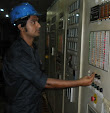Electric Motor
When a current-carrying conductor is located in an external magnetic field perpendicular to the conductor, the conductor experiences a force perpendicular to itself and to the external magnetic field. This is the basic principle of electric motor.
An electric motor is an electromechanical device that converts electrical energy to mechanical energy. This mechanical energy is used as driving force to rotate a pump impeller, fan or blower, driving a compressor, lifting materials etc. Electric motors are sometimes called the work horses of the industry because it is estimated that motors use about 70% of the total electrical load of the industry/plant.
Principle
The general working mechanism is the same for all motors-
- An electric current in a magnetic field will experience a force
- If the current carrying wire is bent into a loop then the two sides of the loop, which are at right angle to the magnetic field, will experience forces in opposite directions.
- The pair of forces creates a turning torque to rotate the coil
- Practical motors have several loops on an armature to provide a more uniform torque and the magnetic field is produced by electromagnet arrangement called the field coils.
 |
| Working principle of ac and dc motor |
 |
| working principle |
An electric motor consists of a permanent external field magnet (stator) and a coiled conducting ammeter (rotor) which is free to rotate within the field magnet. Brushes and a commutator (designed differently if A.C. or D.C. current is supplied to the armature) connect the armature to an external voltage source. The speed of rotation of a motor depends on the amount of current flowing through it, the number of coils on the armature, the strength of the field magnet, the permeability of the armature, and the mechanical load connected to the shaft.
 |
| Electric motor |
 |
| Motor winding |
Practical real motors usually have at least a three-slot armature, and a commutator with three segments. There are however still only two brushes. Higher voltage and higher efficiency motors have even more slots (an odd number) and more segments on the commutator (the same as the number of slots), and more brushes (always an even number). Photos 1 and 2 show the armature, commutator, and brushes from a typical low-cost three-slot motor.
Classification
The main two types of electric motors: Alternating current (AC) and Direct current(DC) motor. The further classification given below
 |
| Classification of motor |








